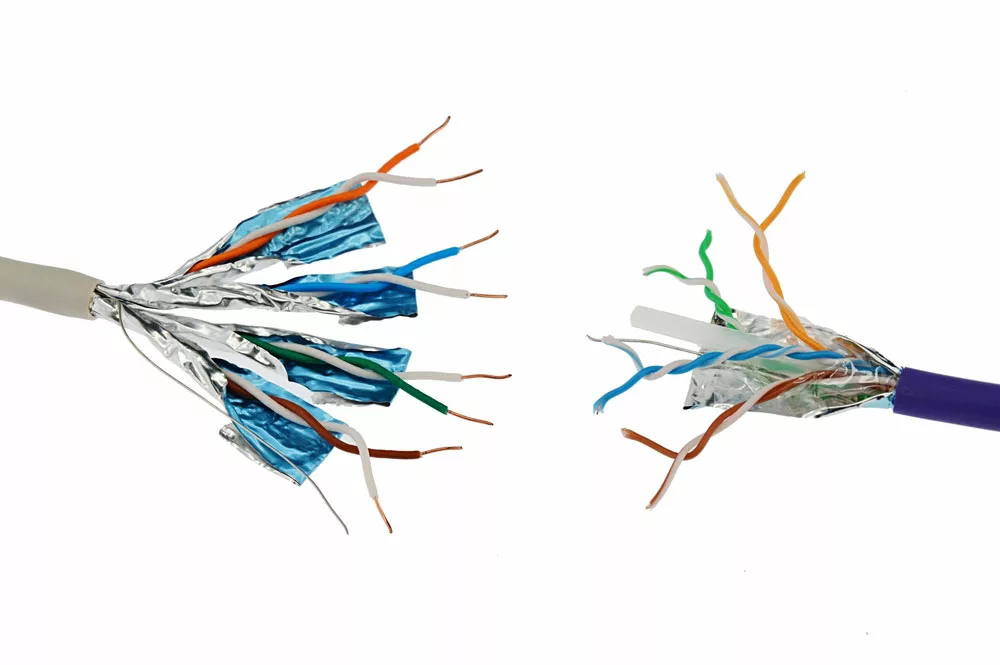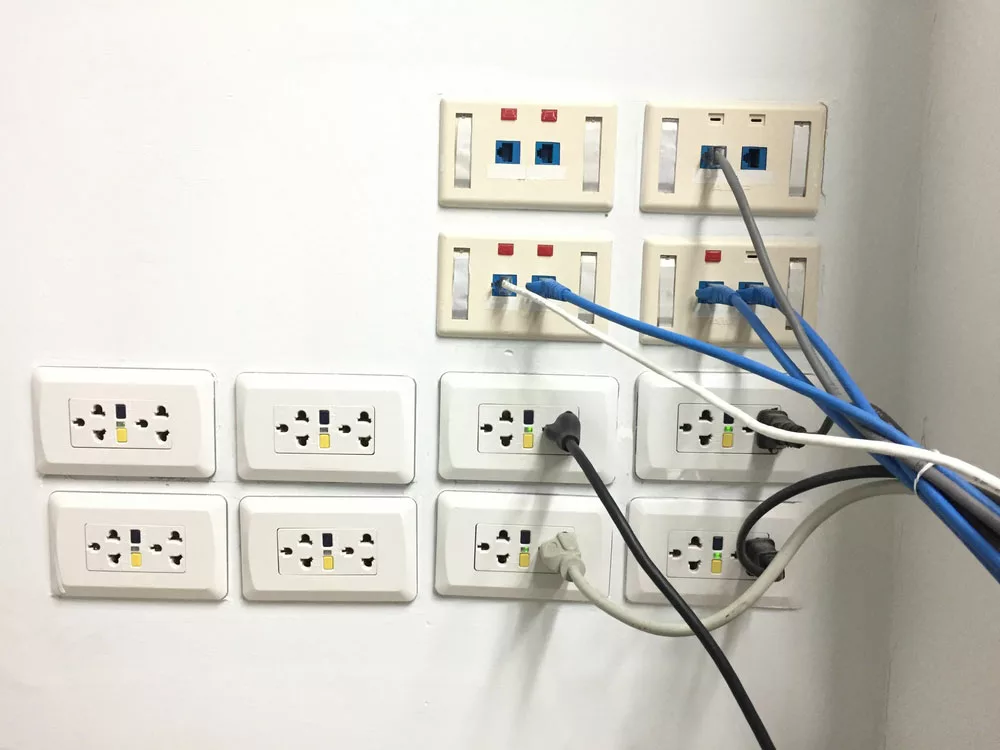About Grounded Ethernet Cable, You can use different network patch cables to install or update your network infrastructure.
Among the other choices, you must decide whether to use STP/ shielded or UTP/ unshielded twisted pair.
While twisted pairs of UTP can protect against interference to a large extent, STP does it more effectively.
However, it is essential to ground the STP cables. Why?
Let’s discuss the importance of bonding and grounding Shielded Ethernet cables and different ways to ground the cables.
Table of Contents
- Shielded Vs. Unshielded Ethernet cable: the basics on why you need the grounded ethernet cable
- Grounding shielded Ethernet cables:
- Conclusion:
Shielded Vs. Unshielded Ethernet cable: the basics on why you need the grounded ethernet cable
Ethernet cables comprise four pairs of twisted wire conductors, which help to transfer signals from one point to another.
There are two types of ethernet cable: shielded twisted pair and unshielded twisted pair.
In the shielded ones, the wire conductors have outer shielding; in unshielded ones, it has not.
Using a twisted pair minimizes electromagnetic interference caused by nearby appliances and power devices.
So, why do we use shielded cables if twisted pairs protect against interference?
In some applications, unshielded twisted pairs are enough to minimize EMI, while in others, you need shielding over wire conductors for extra protection.
For instance, EMI is not a significant issue in home or small business setups, and twisted pairs inside the network cable are enough for high-quality data transmissions while protecting the data against minor interference.
No extra shielding is required here, and you can use an unshielded twisted pair or UTP.
UTPs are less expensive, easy to install, require no grounding, and are more pliable than STPs.
However, in complex business setups, external interference comes through high-power elevators, motors, heavy machinery, and lighting installations.
Such high-level interferences can have a major impact on data transfer speed.
In such cases, you will need extra protection that comes through shielded twisted pair cables.
STPs are of two types:
STP Ethernet cables: In these, all four twisted wire pairs are wrapped in a tightly braided wire or foil.
After individual wrapping, all four pairs are combined and wrapped in another braided or foil shielding layer.
The wrapping around the conductors makes these cables thick, expensive, and difficult to install.
FTP Ethernet cables: The foil-shielded twisted pair has only one foil wrapped around all four pairs.
There is no wrapping around individual twisted pairs. As FTP has added shielding than UTP, they are more expensive, but due to only one layer of protection, they are less expensive than STP.
Pros and cons of STP:
Pros: In high-speed network connections, external crosstalk arises in twisted pairs, which hinders data transmission.
STP cables offer protection against such interference for smooth data transmission.
Also, in case of sensitive data transmission, STP ensures that data remains within the network and does not get leaked easily.
Cons: Despite such benefits, STP is not always a great choice in Ethernet cables because the massive thickness of these cables makes it stiff and difficult to run the cables through tighter spaces.
If mishandled, they can lead to breaks and cracks. The task becomes highly time-consuming as you need to be careful during installation.
Also, unlike UTP, which does not require any grounding, STP and FTP cables require a ground path to bury the current formed by the intercepted EMI.

STP and FTP ethernet cables
Grounding shielded Ethernet cables:
ANSI has set various standards for grounding shielded cables in commercial buildings and requires them to be accurately grounded in the telecom rooms or at places where they terminate.
Most shielded outlets have an automatic connection to the panel’s ground and do not require setting up a ground path for individual cables.
It would be best if you ensured that the panel bonds to the ground by the standards.
Also, ensure that both cable ends are grounded in the same building. Not doing so can create a ground loop, leading to a drastic negative impact on the connection performance.
Based on other standards, ISO/IEC requires you to ground all components on STP/FTP Ethernet cables.
You are not allowed to mix different STP cables, UPT cables, connectors, and network controllers.
Are bonding and grounding the same?
Though these two terms are related, they have entirely different meanings.
Bonding refers to creating an electrical path of low resistance from one conductive thing to another.
It helps to provide a grounded path for unwanted voltage in adverse events like:
- Faults in electrical systems
- Electromagnetic interference and radio frequency interference (EMI and RFI)
- ESD or Electrostatic discharge
Grounding means earthing, which means creating a zero-volt potential to Earth.
The ground is established between the Earth and the electric system in your home’s electrical system.
With this, you create an intentional path for any faulty current or electrostatic discharge to drain off.
Thus, you equalize your home’s electrical system and other equipment’s potential with the Earth’s potential.
The ground rods and GECs help establish this grounding.
How to ground the Ethernet cable?
Unlike any industrial establishment, you do not have cable trays, device racks, and metallic conduits at your residence, and you only have to worry about grounding the ethernet cable shields.
In Shielded twisted pairs, the cable shield gets in touch with a drain wire or a tinned copper wire, along with the foil shield.
You can bond with the connection hardware/keystone jack through the following methods:
- Electrically bond the cable shield to the keystone jack. As soon as you do this, the outer metal of the keystone jack forms part with drain wire and cable shield. Now, they all function as a single unit.
- You can remove the cable shield and use the drain wire directly for bonding.
- You can also remove the cable shield and tack down the covered drain wire with conductive tape made of copper. The process is most suitable for RJ45 8 position 8 Conductor terminations.
Once you successfully bond the cable shield to the termination hardware, you must continue that bonding throughout the circuit path.
You can do it using three methods based on the environment and equipment:
- Using a toolless Ethernet patch panel that already bonds to the ground.
- Using the above method and Ethernet patch cords to an efficiently grounded network switch.
- Only use Ethernet patch cords to correctly ground the network switch.
What do you understand by a properly grounded network/ethernet switch?
The ethernet switch uses a three-prong power cord, such as a 19-inch switch (rack mounted) with its own AC/DC power supply.
A small desktop switch having a prong DC/AC adapter is not categorized as properly grounded.
You cannot use this to ground the path of your Ethernet cable shield.
In this case, you must ground the ethernet patch panel through a ground wire separately.

Safely grounded ethernet cables(the blue ones)
Conclusion:
So, why and how to ground shielded ethernet cables must be clear. Whether you use STP or UTP, always use high-quality cables.
The higher quality ensures that cables will last longer without service, thus saving replacement and maintenance costs.
You can get such high-quality cables at Cloom. We are a leading manufacturer of various customized cable assemblies and wiring harness solutions.
